|
 Number Line Addition and Subtraction |
Addition and subtraction on a number line can be applied to integers and rational numbers.
The number line can be used to add and subtract signed numbers.
For adding and subtracting positive numbers, the movement on the number line is as would be expected. Adding go right. Subtracting go left.

This form of addition and subtraction is easy to see with adding going to the right and subtraction going to the left. But, then we have the adding and subtracting of negative numbers and our easy process becomes a bit harder.
If you are adding a negative number, you will need to move in a negative direction (meaning left instead of right), as the negative indicates the opposite of adding that value.
3 + (-7) becomes 3 - 7, and 9 + (-3) becomes 9 - 3.

Also, if you are subtracting a negative number, you will need to move in a positive directions, (meaning right instead of left) as the negative indicates the opposite of subtracting that value.
-4 - (-3) becomes -4 + 3 and 3 - (-6) becomes 3 + 6.
Remember, we saw that the "opposite of the opposite of a number is the number itself".
That is, two negative signs in a row turn into a positive, so 3 - (-6) = 3 + 6.

This number line strategy for adding and subtracting numbers is fine for working with smaller values. But, when the numbers become larger, it will becomes too difficult to actually draw the number lines.
With this in mind, we will consolidate the processes needed for working with integer and rationals into three basic procedures for dealing with arithmetic ( +, -, x, /) of signed numbers. See Arithmetic of Signed Numbers.
|
 Number Line Multiplication and Division |
Multiplication and division on a number line can be applied to integers and rational numbers.
The number line can be used to multiply and divide signed numbers.
MULTIPLY:
Positive number x Positive number.
For multiplying two positive numbers,
(2 x 3), start at 0 on the number line, and move to the right in "2 groups of 3".
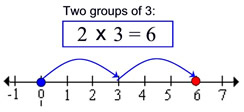 |
Positive number x Negative number.
For multiplying a positive number times a negative number, (2 x -3), start at 0 on the number line, and move to the left in
"2 groups of -3".
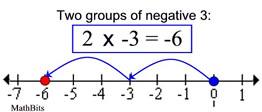
|
Negative number x Positive number.
For multiplying a negative number times a positive number, (-2 x 3), we will use the commutative property and reverse the problem to be (3 x -2). Now, we have the same process that we saw above.
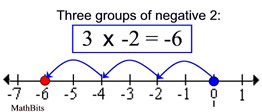
|
|
Negative number x Negative number.
For multiplying a negative number times a negative number, (-2 x -3), it gets a little harder.
We have been using the "first" factor in each problem to designate the number of times to "group" the second factor in each problem. We cannot count the number of groups as being a negative number, but we can remember that -2 is the opposite of +2. Since our "grouping" number is negative, our final answer will be the opposite of the answer when using +2.
 |
DIVIDE:
Positive number ÷ Positive number.
For dividing two positive numbers,
(6 ÷ 3), start at 0 on the number line, plot the dividend (6), and group off sections of 3 units.
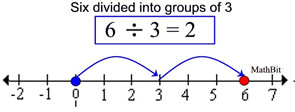
Since there are two "groups",
6 ÷ 3 = 2. |
Negative number ÷ Negative number.
The dividing of a negative number by a negative number, (-6 ÷ -3), is actually easier than the divisions involving a single negative sign. We are dividing -6 into groups of -3 units. It is a count of 2 such groups.
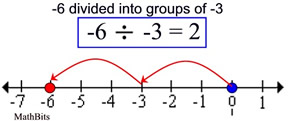 |
Positive number ÷ Negative number.
When dividing positive number by a negative number, (6 ÷-3), we can see that the factor of -3 is not within the range of +6. It is on the opposite side of zero. We do see, however, that 2 groups of -3 will place us at -6. So, 2 is the grouping number we are looking for, but we need it in the opposite direction. The -2 grouping number will indicate opposite direction, getting us to +6.
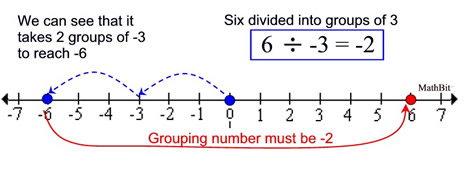 |
Negative number ÷ Positive number.
For dividing a negative number by a positive number, (-6 ÷ 3), we see the same problem we saw with dividing a positive by a negative. We are on the wrong side of zero to solve this problem easily. We see that 2 groups of +3 will place us at +6. So, 2 is the grouping number we are looking for, but we need it in the opposite direction. The -2 grouping number will indicate opposite direction, getting us to -6.
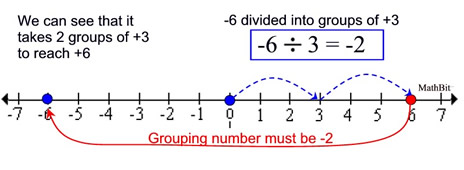 |

NOTE: The re-posting of materials (in part or whole) from this site to the Internet
is copyright violation
and is not considered "fair use" for educators. Please read the "Terms of Use". |
|
|